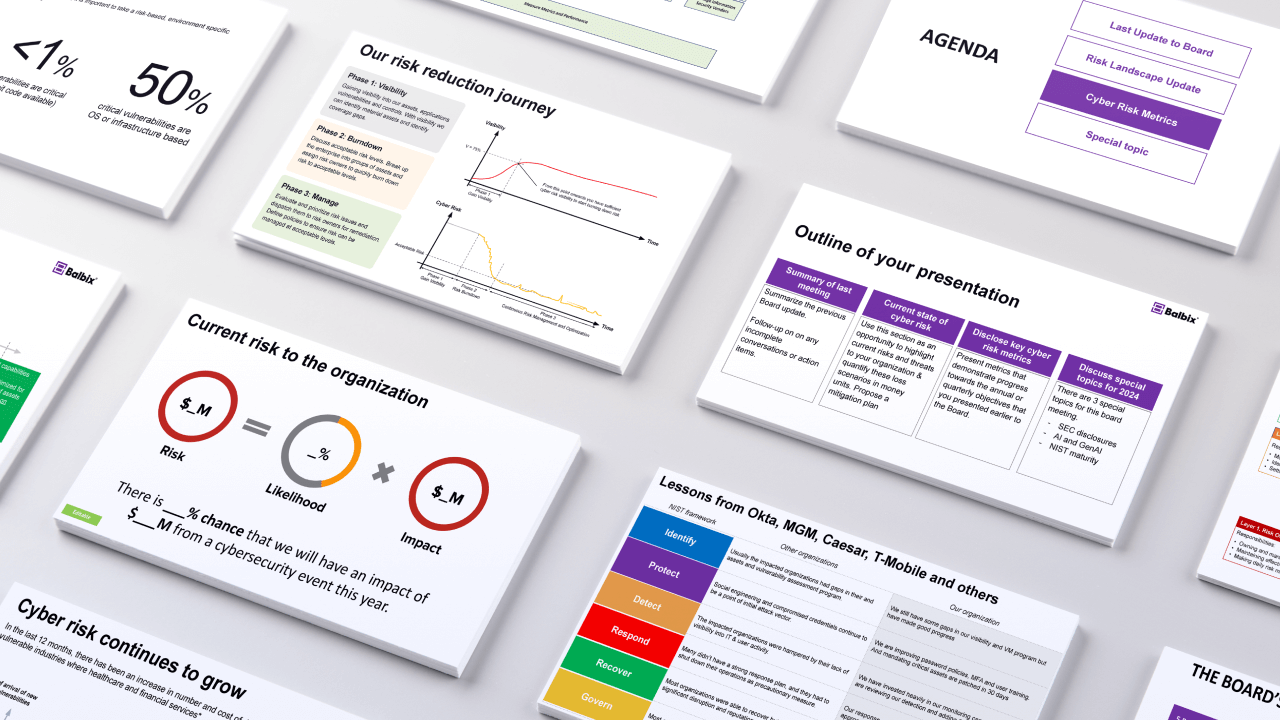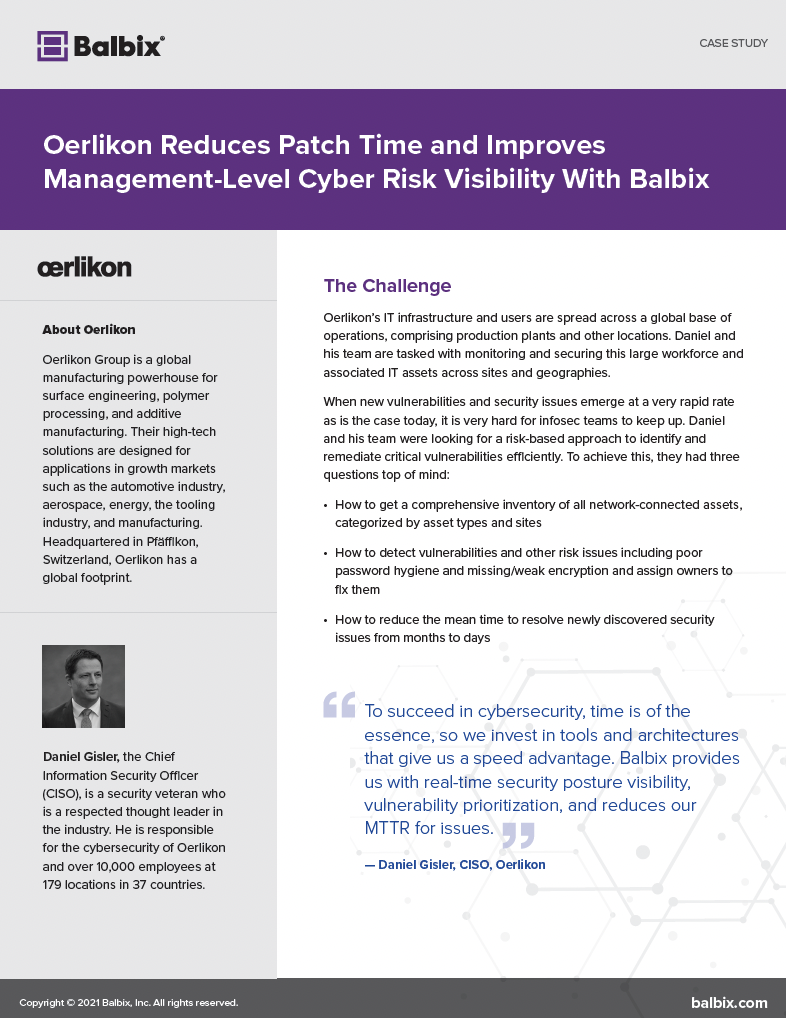What is IT Risk Management?
IT Risk Management is the application of risk management methods within an organization that can be used to mitigate cyber threats. By deploying the appropriate security tools and processes, organizations are able to assess, analyze and quickly mitigate the potential vulnerabilities within their IT network, limiting the impact of security incidents.
The current reality is that cyber threats are complex, and a strong IT Risk Management program is key to protecting your organization against an ever-changing threat environment where new risks and vulnerabilities are constantly emerging.
Challenges to implementing IT Risk Management
Implementing IT Risk Management initiatives are doable, but organizations often lack the appropriate technologies, knowledge and procedures needed to effectively and efficiently manage their risk:
Organizations lack full visibility into their assets
Assessing cyber risk is a critical component of IT Risk Management that requires full visibility of all your assets across your entire network. This is challenging for organizations to do because enterprise assets change constantly, with devices being added and retired, physical machines migrating to virtual, users coming and going, and various stakeholders installing and updating software (with or without approval). Additionally, different parts of an organization may use separate tools for mitigating risks and lack an up-to-date inventory of IT assets making compliance and cyber risk management difficult to do.
Organizations lack an accurate assessment of their risk level
Even with an accurate inventory of your assets, it is challenging for organizations to determine how vulnerable they are to potential breaches and cyber-attacks. This requires identifying risks to your assets by monitoring assets for vulnerabilities including the likelihood of breach via a range of attack vectors and the impact if a particular asset were to be breached. Organizations using legacy vulnerability tools may have difficulty assessing which of their vulnerabilities are critical and monitoring the entire enterprise attack surface. If you don’t have a clear understanding of your network’s cybersecurity framework, its security controls, its vulnerabilities and its gaps, you won’t know the IT Risk Management initiatives you need to take to stay protected.
Organizations struggle to monitor their threat environment
With cybersecurity breaches, it’s no longer a question of “if” but “when”. IT Risk Management requires continuous scanning and monitoring across a broad range of attack vectors. Cyber threats are constantly evolving and it’s important to continuously monitor your IT environment to detect weaknesses and remediate risks. Organizations wrongly believe that cyber security management is not a continuous process, but security teams need to constantly monitor IT environments to ensure internal controls and procedures are strong enough to keep up with evolving cybersecurity threats.
Importance of IT Risk Management
Risk is greatly tied to uncertainty, which is why establishing IT Risk Management initiatives helps organizations better prepare for cyber attacks and minimize the impact of a cyber event, should it occur. The policies, technologies and procedures implemented within an IT Risk Management program can help guide decision-making around risk control and establish mitigation strategies so organizations can stay protected and achieve their business goals. A successful IT Risk Management program will help you answer the following questions:
- Do we have a complete inventory of all our assets?
- Do we have real-time visibility into our entire attack surface?
- How comprehensive and effective is our overall cybersecurity infrastructure?
- How effective and resilient are our cybersecurity defenses?
- Can we prioritize our vulnerability management actions based on business criticality and risk?
- How vulnerable are we to potential breaches and attacks?
- What risk management methods should we deploy to maintain cyber resilience?
Each organization’s cyber risk has many moving parts. That said, understanding and defining the full scope of your cybersecurity posture is essential to IT Risk Management and crucial to protecting your business against the high cost of data theft and breaches.
How does IT Risk Management work?
When it comes to IT Risk Management, organizations typically follow a multi-step process beginning by identifying potential risks and assessing these risks based on the likelihood of threat and their potential impact. Risks are then prioritized, and mitigation strategies are put in place. The last step is to continuously monitor the IT network to ensure the organization is protected despite a shifting threat environment.
The IT Risk Management processes are explored in-depth below:
Identify and assess risk
Risk identification is the first step in the IT Risk Management process. When looking to identify risk, you must start by obtaining a big-picture view of your enterprise in terms of all the assets – devices, users, and applications – connected to your environment and their breach risk. Usually, the IT assets that you cannot see are the ones that pose the biggest risk. True visibility will come from knowing exactly how many devices – managed, unmanaged, BYO, IoT, etc. – are part of your network, understanding which of these assets are highly critical for your business and which ones are less important, how likely each asset is to be compromised, and how attacks might propagate from risky systems to your critical assets. An automated asset discovery tool helps discover and inventory all assets, enabling your enterprise to maintain an up-to-date asset inventory that is real-time, highly accessible and continuous.
With an accurate inventory of your assets, you can perform a cybersecurity risk assessment to gather information about your network’s cybersecurity framework, its security controls, its vulnerabilities, and any gaps. Your goal is to determine any exposures or risks that exist across networks, devices, applications, and users. Once identified, you will need to rate how big a risk these problem areas are in terms of your specific business, what you’re currently doing to mitigate the issues you’ve identified, and what still needs to be done. A risk-based approach to vulnerability management will help your organization identify vulnerabilities due to numerous attack vectors across all your assets and prioritize them based on actual risk by understanding the context around each vulnerability and the enterprise asset it affects. Armed with this information, you can implement an IT Risk Management strategy that will enable your security team to be better equipped to tackle your vulnerabilities in the most efficient manner.
Control and mitigate risk
Identifying and assessing risk is just the beginning of applying IT Risk Management methods to your security efforts. You need to determine what your organization is going to do about the risk they identified and what their mitigation response will be for managing risk. The most successful security teams will have a thought-out plan to guide their IT Risk Management strategy. This starts by understanding all your options to mitigate risks – you can either employ technological or best practices or a combination of both. Technological mitigation efforts can include engaging automation for increased system efficiency, updating software and employing threat intelligence technologies. Best practices encompass deploying security training programs, hiring more security talent nd implementing new procedures and better internal controls to streamline security efforts across the organization. Concrete mitigation controls in place will ensure that your enterprise is able to successfully function during and after a cyber incident.
Continuously monitor risk
Continuously monitoring your risk landscape is at the core of implementing an effective IT Risk Management program. In the face of increasingly prevalent and sophisticated cyber-attacks, organizations must evolve their security posture from a purely defensive and reactive stance focused on malware to a more proactive approach of predicting and mitigating breaches, which will improve both cyber-resilience and security team productivity. Continuous monitoring isn’t just about having full asset visibility, it’s about creating a risk evaluation of all your critical systems so you can prioritize security resources and efforts more efficiently. With the help of a risk-based automated tool, you can accurately track your security performance, identify security gaps, audit control effectiveness as well as drive accountability around cyber security management. Continuously monitoring risk also increases your decision-making power around security management and helps your security team detect and quickly mitigate cyber threats, enabling continued business operations.
Best practices for IT Risk Management
IT Risk Management is a strategic approach to managing cyber risk, but it cannot eliminate all vulnerabilities within an organization or block all types of cyberattacks. The attack surface is constantly changing, but with the right IT Risk Management approach, your security team can be better equipped to tackle vulnerabilities and enhance its security posture. IT Risk Management best practices include:
- Recognize what you are trying to protect by discovering and inventorying all IT assets including systems, applications, devices, data, business processes, and users.
- Proactively map the organization’s attack surface, understanding its weak points and where it is likely to be breached.
- Identify risks to your assets by monitoring assets for vulnerabilities including the likelihood of breach via a range of attack vectors and the impact if a particular asset were to be breached.
- Create a risk mitigation strategy for early detection and quick recovery in the event of a cyber attack, enabling continuous business operations.
- Employ continuous and automated monitoring of your risk across the enterprise so you can quickly adjust to a constantly changing threat environment.
Frequently Asked Questions
- What is IT Risk Management?
-
IT Risk Management consists of the policies, technologies, and procedures that an organization uses to mitigate threats and reduce vulnerabilities across its network. IT Risk Management works by first identifying and assessing IT assets to understand the level of threat they pose to the organization. Risks are then prioritized and mitigated depending on their vulnerability criticality. The last step is to continuously monitor the IT network to ensure the organization is protected despite a shifting threat environment.
- What is IT risk?
-
IT Risk is any threat posed to business data, network systems and enterprise operations when an IT vulnerability is exploited. IT Risks can stem from poorly managed internal security controls and equipment failure to target cyber attacks. Unmanaged IT Risk has the potential to significantly disrupt business operations resulting in monetary and financial losses, privacy invasion, reputation damage and compliance issues.
- What are the types of IT risks?
-
The types of IT risks that can potentially affect your business can fall under physical threats, resulting from physical access or damage to resources like internet servers, and electronic threats, like installation of ransomware aimed at compromising your business information. Other IT risks include technical failures, such as software bugs or hardware and software failures, infrastructure failures such as loss of internet connection, or human error from someone accidentally deleting important data or failing to follow security procedures properly.


